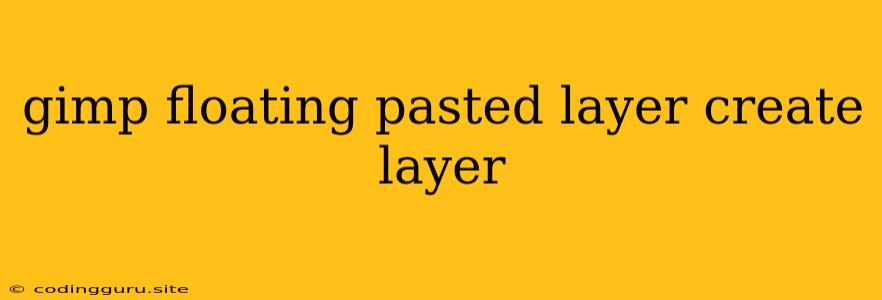Working with Floating Pasted Layers and Creating New Layers in GIMP
GIMP, the GNU Image Manipulation Program, is a powerful and free open-source image editor that offers a plethora of tools and features for image editing, manipulation, and creation. One common task in GIMP involves pasting images or selections onto the canvas, which often results in a floating pasted layer. Understanding how to work with these layers and create new layers effectively is crucial for efficient image editing.
What is a Floating Pasted Layer?
When you copy or cut a selection or an entire image from another source and paste it into GIMP, it doesn't automatically become a permanent part of your existing image. Instead, GIMP creates a floating pasted layer, a temporary layer that hovers above the existing layers. This floating layer is essentially a separate entity, allowing you to reposition, resize, and manipulate it independently before committing it to your image.
Creating a New Layer
Before we delve into the intricacies of floating pasted layers, let's understand how to create a new layer from scratch. Creating a new layer is essential for non-destructive editing, allowing you to work on different elements of your image without affecting other layers.
Here's how you can create a new layer:
- Open your image in GIMP.
- Go to Layer > New Layer....
- In the New Layer dialog box, you can customize the layer's name, transparency, and other options.
- Click OK to create the new layer.
Working with Floating Pasted Layers
Now, let's get back to floating pasted layers. Here's a breakdown of common actions and considerations when working with them:
-
Repositioning the Floating Layer: To move the floating pasted layer, simply click and drag it to your desired position.
-
Resizing the Floating Layer:
- Click on the floating pasted layer in the Layers panel.
- Select the Scale Tool from the toolbox.
- Click and drag the handles to resize the layer.
- Alternatively, you can use the Transform menu for more precise scaling options.
-
Rotating the Floating Layer:
- Click on the floating pasted layer in the Layers panel.
- Select the Rotate Tool from the toolbox.
- Click and drag the rotation handle to rotate the layer.
-
Transforming the Floating Layer: You can use various transform tools in GIMP to manipulate the floating pasted layer, including scaling, rotating, flipping, shearing, and perspective transformation.
-
Applying Effects to the Floating Layer: You can apply various effects, filters, and adjustments to the floating pasted layer without affecting the underlying layers.
Converting the Floating Pasted Layer into a Permanent Layer
To make the floating pasted layer a permanent part of your image, you need to anchor it. There are two main ways to achieve this:
- Click the "Anchor Layer" Icon: In the Layers panel, locate the anchor icon (a small anchor symbol) next to the floating pasted layer. Click this icon to anchor the layer.
- Right-Click and Select "Anchor Layer": Right-click on the floating pasted layer in the Layers panel and select "Anchor Layer" from the context menu.
Understanding Layer Modes
When you anchor a floating pasted layer, you have the option to choose a layer mode. Layer modes determine how the pasted layer interacts with the underlying layers in terms of blending, color, and transparency. GIMP offers a wide variety of layer modes, including:
- Normal: This is the default mode, displaying the pasted layer as it is.
- Multiply: This mode darkens the underlying layers.
- Screen: This mode lightens the underlying layers.
- Overlay: This mode blends the pasted layer with the underlying layers based on the colors.
- Hard Light: This mode creates a dramatic effect by blending the pasted layer with the underlying layers based on their luminance values.
- Soft Light: This mode creates a subtle effect by blending the pasted layer with the underlying layers based on their luminance values.
Working with Multiple Floating Pasted Layers
You can have multiple floating pasted layers on your canvas, allowing you to build up your image in stages. When working with multiple floating pasted layers, you can use the Layer menu to rearrange their order, merge them, or perform other operations.
Tips and Best Practices
- Always create a new layer before pasting an image or selection to ensure non-destructive editing.
- **Use the floating pasted layer to experiment with different positions, sizes, and effects before anchoring it to your image.
- Choose the appropriate layer mode based on the desired blending effect.
- **Use the Layers panel to manage the visibility, order, and properties of your layers.
Conclusion
Floating pasted layers and creating new layers are fundamental concepts in GIMP. By mastering these techniques, you gain complete control over your image editing workflow. Whether you're compositing images, creating photo manipulations, or building complex designs, understanding how to work with layers effectively will greatly enhance your image editing skills.
